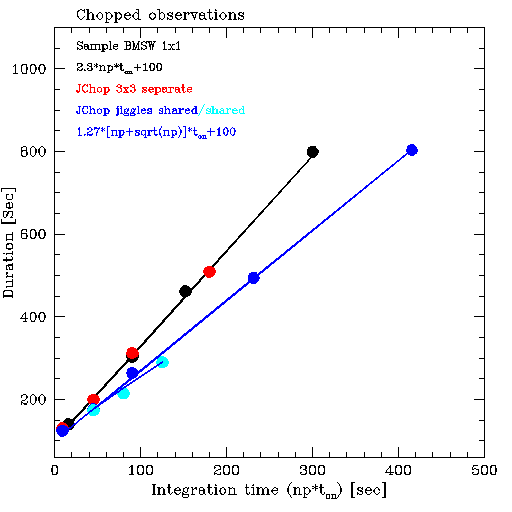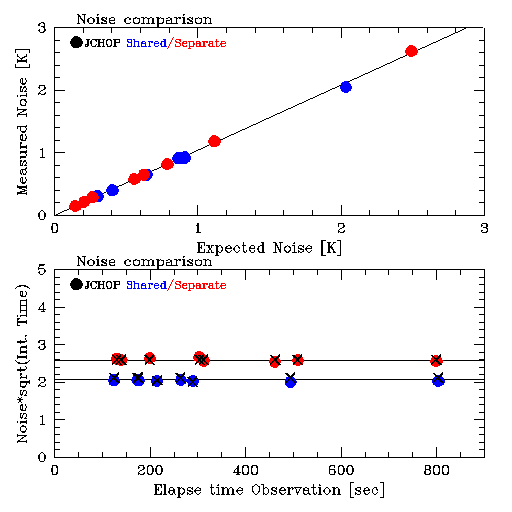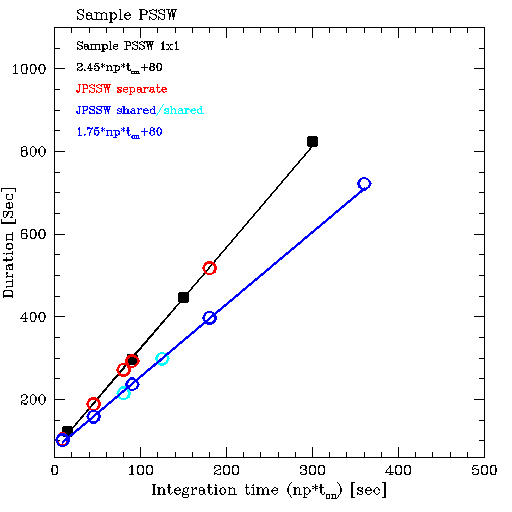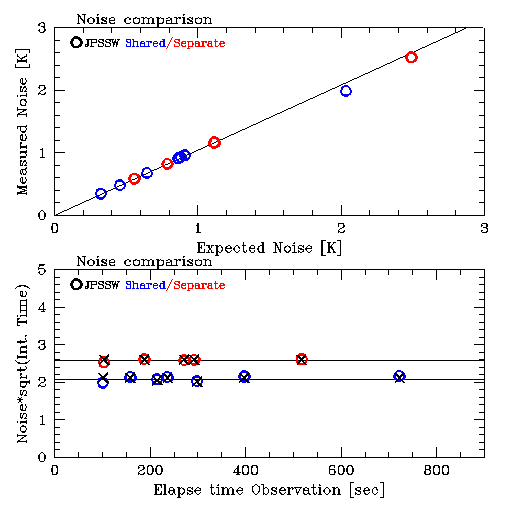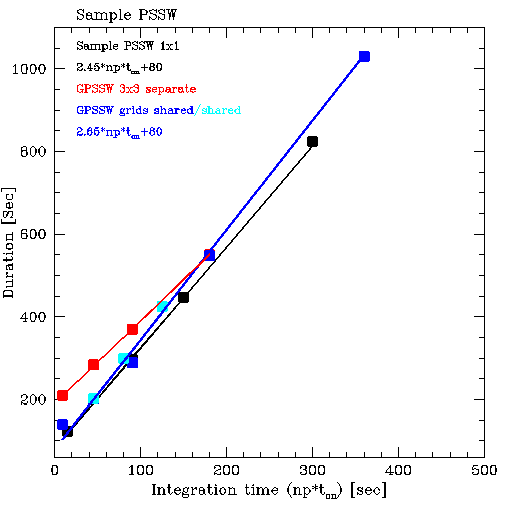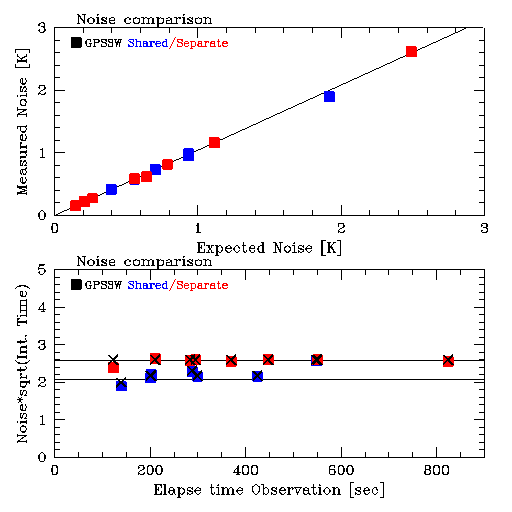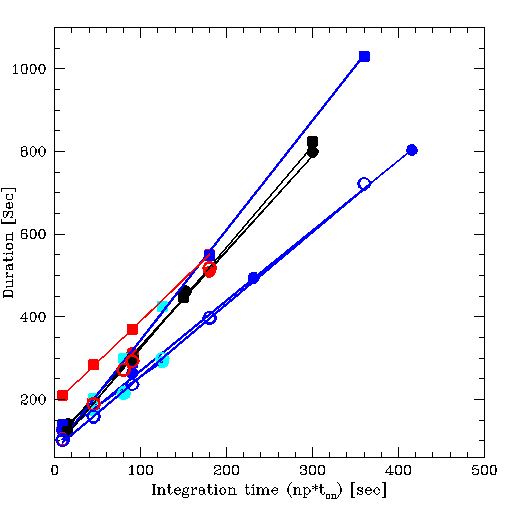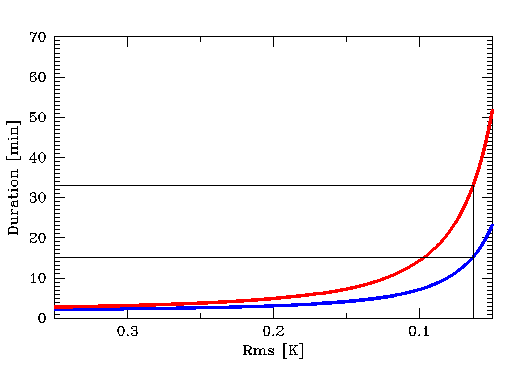Main Heterodyne Observing modes page
(Note: the loop control parameters mentioned below cannot be changed in MSBs; the TSS can modify some of them if necessary)
Jiggle-chop observations
Duration:
The figure below illustrates the duration of observations based on the UT timestamps in the headers. The duration scales linearly with the requested integration time for single-point beam-switched observations (black dots and line). JCHOP maps with separate offs (red dots) follow the same relation which is not surprising since the motion of the secondary is not a dominating factor. JCHOP maps with shared offs also scale linearly with the requested integration time (blue dots and blue line), but require significantly less time than their separate counterpart and, as expected, this effect scales non-linearly with the number of points in the jiggle (cyan points — 3×3, 4×4, 5×5 pattern, respectively — and blue line). The durations in the plot include an additional ~60secs before the start UT is written or closing the files after the end UT timestamp. The approximate relations thus become (np: number of points in jiggle; t_on: requested ‘on’-only integration time per jiggle-point):
| Jiggle-Chop | Duration (secs) |
|---|---|
| Separate off or 1×1 BMSW | 2.3 * np * t_on + 100 |
| Shared off | 1.27 * [np +sqrt(np)]* t_on + 100 |
Noise:
The figure below shows the noise in Jiggle-Chop observations. The top panel compares the observed noise to the expected noise, for chopped observations ranging from single-position to 5×5 jiggles, both using shared and separate offs. Overall the agreement is excellent, but the data indicate an excess noise of about 4% (the black line).
The expected noise can thus be calculated using:
rms = 1.04 * Tsys*1.23/sqrt(df*t_on) * sqrt(1+1/sqrt(np))
1.04: 4% excess noise, presently unexplained
1.23: Correlator digitization factor
df: channel-spacing in Hz
t_on: 'on'-only integration time in sec
np: 1 for separate offs else the number of point
sharing an off. For patterns not exceeding 9x9
this is the number of points in the jiggle pattern.
The bottom panel shows the normalized noise: rms*sqrt(int. time) as a function of the duration of the observations with the noise calculated using the equation above indicated by the black crosses. As expected the normalized noise is independent of the duration and type of the observations, indicating no unexplained sysystematic effects, with one significant exception: all observations with shared offs have about 20% less noise than their separate
counterparts. Together with the previous figure above, this panel illustrates the point made when discussing separate offs: not only do observations with shared offs take less time for the same amount of integration time, the resulting noise is lower as well.
Jiggle-Position Switch observations
Loop control:
There are two parameters that control the execution of the JPSSWobservation: the step_time, the max_time_between_refs. As for JCHOP, the step_time is the dwell time per jiggle position and has a minimum of 0.1s. The max_time_between_refs is the maximum time that can be spend observing jiggle positions before a position switch to the sky reference is require; its current default is 30s. Note that in order to minimize the overhead of the position switch, the rate of going to the sky position is less than for JCHOP which can result in worse baselines.
The dwell time per jiggle position is calculated such that it is as long as possible to allow the pattern to be completed within the max_time_between_refs, but not to exceed 2s per point. As for JCHOP there is a continuum mode which changes the max_time_between_refs to 5s at the cost of more overhead. Note that position-switch observations are not well suited for measuring the continuum level, both because of their typically larger switch, as well as the relatively long time between sky references even in continuum mode.
Duration:
The figure below illustrates the duration of observations based on the UT timestamps in the headers. The duration scales linearly with the requested integration time for single-point position-switched observations (black squares and line). JPSSW maps with separate offs (red circles) follow the same relation which is not surprising since the motion of the secondary is not a dominating factor. JPSSW maps with shared offs also scale linearly with the requested integration time (blue circles and blue line), but require significantly less time than their separate counterparts. Contrary to JCHOP observations, and for reasons not obvious, the same linear relation fits patterns of different size (cyan circles — 4×4, 5×5 pattern, respectively — and blue line). The durations in the plot include an additional ~60secs before the start UT is written or closing the files after the end UT timestamp. The approximate relations thus become (np: number of points in jiggle; t_on: requested ‘on’-only integration time per jiggle-point):
| Jiggle-PSSW | Duration (secs) |
|---|---|
| Separate off or 1×1 PSSW | 2.45 * np * t_on + 80 |
| Shared off | 1.75 * np * t_on + 80 |
Noise:
The figure below shows the noise in Jiggle-PSSW observations. The top panel compares the observed noise to the expected noise, for PSSW observations ranging from single-position to 5×5 jiggles, both using shared and separate offs. As for JCHOP the data indicate an excess noise of about 4% (the black line). The bottom panel shows the normalized noise: rms*sqrt(int. time) as a function of the duration of the observations with the noise calculated using the equation above indicated by the black crosses.
See Jiggle-Chop for a more detailed discussion
Grid Position-Switch
Loop control:
There are two parameters that control the execution of the GPSSW observation: the step_time_grid_pssw, the max_time_between_refs. As for the other modes the step_time is the minimum dwell time per point, but for GPSSW it’s default value is 1.0s rather than the 0.1s for jiggles. The max_time_between_refs, default 30s, is the maximum time that can be spend observing grid positions before a position switch to the sky reference is require. The rate of going to the sky position is less than for the equivalent JCHOP observation, which can result in worse baselines.
Similar to JPSSW, there is continuum mode for GPSSW, which changes the max_time_between_refs to 5s at the cost of more overhead. Note that position-switch observations are not well suited for measuring the continuum level both, because of their typically larger switch, as well as the relatively long time between sky references even in continuum mode.
Duration:
The above conclusion is illustrated in the plot below, which shows the duration of observations based on the UT timestamps in the headers. The duration scales linearly with the requested integration time for single-point position-switched observations (black squares and line). GPSSW maps with shared offs also scale linearly with the requested integration time (blue squares and blue line), but require a bit more time than their 1×1 counterpart due to the telescope motions within the grid. Although the overheads increase for larger maps with more points (cyan points — 4×4, 5×5 pattern, respectively –) the increase is not very large. On the other hand, short maps with separate offs (red squares and line) incur an excessive overhead due to the many switches to the sky reference up to the point
the integration time per grid-point exceeds 15s when the distinction between separate and shared offs vanishes. The durations in the plot include an additional ~60secs before the start UT is written or closing the files after the end UT timestamp. The approximate relations thus become (np: number of points in jiggle; t_on: requested ‘on’-only integration time per jiggle-point):
| Grid-PSSW | Duration (secs) |
|---|---|
| 1×1 PSSW | 2.45 * t_on + 80 |
| Shared off and separate ≥ 15s | 2.65 * np * t_on + 80 |
| Separate off < 15s | 2.0 * np * t_on + 190 |
Noise:
The figure below shows the noise in Jiggle-PSSW observations. The top panel compares the observed noise to the expected noise, for PSSW observations ranging from single-position to 5×5 grids, both using shared and separate offs. As for JCHOP the data indicate an excess noise of about 4% (the black line). The bottom panel shows the normalized noise: rms*sqrt(int. time) as a function of the duration of the observations with the expected noise indicated by the black crosses. The equation used is the same as given in the discussion of JCHOP observations, but ‘np’ is a bit less straightforward:
rms = 1.04 * Tsys*1.23/sqrt(df*t_on) * sqrt(1+1/sqrt(np))
np: number of points with shared offs or 1 if none:
max(1,int(30/t_on)) i.e. the number of t_ons that fit
in 30sec, but no less than 1. (30secs = time_between_refs.)
Observations with shared offs but on integration times in excess of 15s are excuted the same as observations with separate offs.
See Jiggle-Chop for more details.
Comparing Observing modes
The figure below shows the duration all observing modes discussed above and separates into three groups:
- Most efficient: Jiggles with shared offs, either beam-switched (JCHOP) or position-switched (JPSSW). Compared to GPSSW or separate jiggles, these observations take 30% less time.
- Single-position, GPSSW, and JCHOP/JPSSW with separate offs: these observations don’t get the benefit from the shared offs or accrue additional overheads due to e.g. a position switch to the sky
reference. - GPSSW observations with separate offs and integrations time < 15s per grid point: these have excessive
overheads due to increased number of position switches to the sky reference.
In addition to taking less time, JCHOP and JPSSW with shared offs will have a systematically lower noise as well. This is shown in the next two, side-by-side figures. The figure on the right zooms on the lower-left region of the figure top-left. Using the equations above we find that compared to t_on_nonsh = 30s, shared off observations with 16 points will need t_on_sh = 18.75s to reach the same rms. Using the equations for duration of JCHOP observations at the top which include the fixed overheads, one then finds that the shared offs JCHOPS will take about half the time as the separate offs JCHOPS: 15min instead of 33min as is illustrated in the final figure.
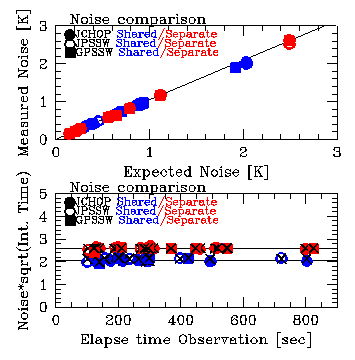
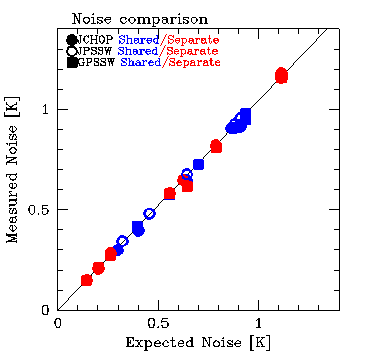
The figure below shows the benefits in terms of the duration of the HARP4 jiggle observation, including realistic overheads, needed to reach a certain rms (assumed Tsys = 250 K and frequency channels of 1 MHz). Note that shared/separate offs are only relevant within a single observation, which typically takes 10-20 minutes: the noise in coadds of successive observations will scale as usual with the sqrt(nr of observations).
Loop control:
There are three parameters that control the execution of the JCHOP observation: the step_time, the max_time_between_chops, and the max_time_between_nods. The step_time is the dwell time per jiggle position and has a minimum of 0.1s. The max_time_between_chops is the maximum time that can be spend observing jiggle positions before a chop to the sky reference is required, currently set to 9s. The max_time_between_nods, current default 30s, determines how many jiggle-patterns and sky references can be observed before the telescope nods to the alternate chop configuration with the reference on the other side of the target.
The dwell time per jiggle position is calculated to be as long as possible to allow the whole pattern to be completed within the max_time_between_chops, but not to exceed 2s per point. For a 16-pt jiggle this means about 0.56s/point and for a 25-pt jiggle 0.36s/point. Note: while the time between chops of 9s is shorter than the 30s typically used with position-switching, it is much longer than what is required for an accurate determination of continuum emission. For this observers can select continuum mode in the their MSB which changes the max_time_between_chops to 0.1s and forces a sky reference for every jiggle position: the observing mode changes to chop-jiggle (chop-before-jiggle) instead of a jiggle-chop (jiggle-before-chop). However, the frequent chops significantly increase the overheads: limited testing so far suggests that the typical penalty for using continuum mode is an increase of the observing time by a factor of 1.7.
Step_time, max_time_between_chops, and max_time_between_nods have been set to defaults that can not be changed by observers directly. Since their optimal settings may depend on e.g. the weather, opacity, and seeing, they are however under the control of the operators, although this is not yet being actively used at present. PIs of science programs that would significantly benefit from settings different from the defaults should contact their assigned support scientist.




